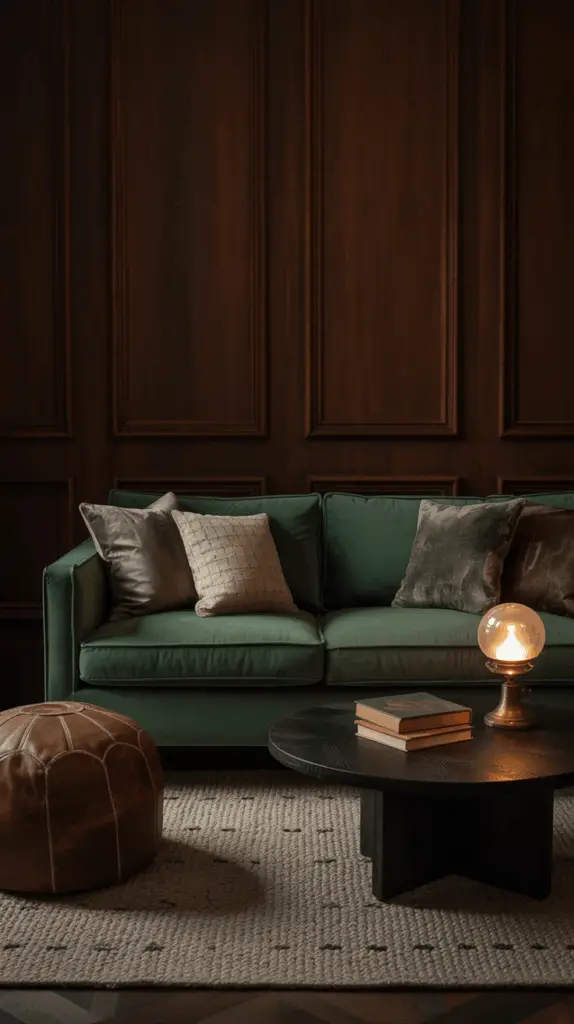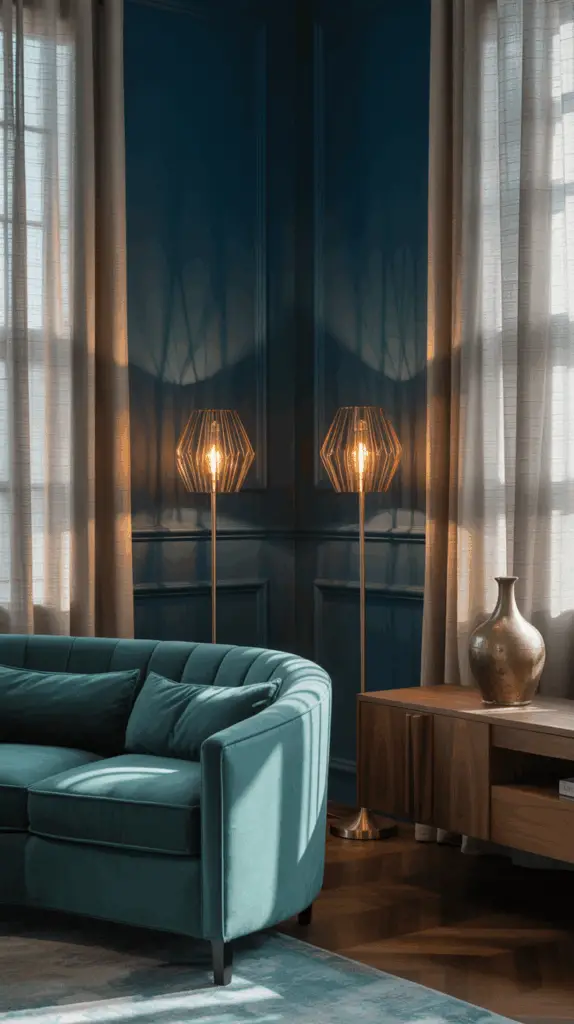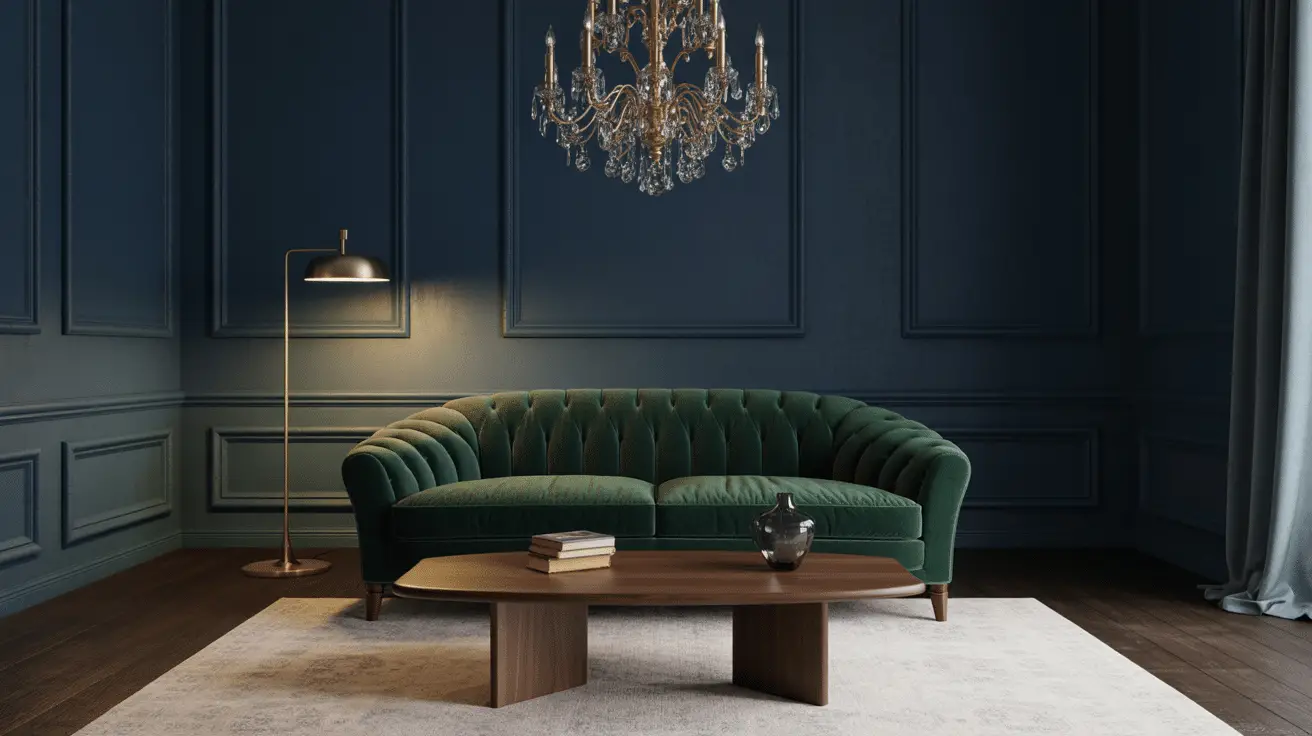How to Style a Dark Moody Living Room Like a Pro: Elegant Design Tips for Dramatic Spaces
Table of Contents
Introduction
Over the past decade, the rise of moody interiors has transformed the way we think about living spaces. While many homeowners still gravitate toward light and airy rooms, a growing number are embracing bold, dark, and atmospheric designs. According to interior design surveys, searches for “dark moody living room ideas” have surged by more than 40% in recent years, showing that people are ready to step away from minimalist whites and grays in favor of deeper, more dramatic tones.
But styling a dark moody living room can feel intimidating. Done incorrectly, it risks looking gloomy or overwhelming. Done right, however, it exudes sophistication, intimacy, and depth. Dark spaces not only feel cozy but also add a luxurious edge, making them perfect for those who want their living room to make a statement.
This article will walk you through the essential steps to styling a dark moody living room like a pro. From choosing the perfect palette and layering textures to incorporating lighting, furniture, and accessories, each section offers practical strategies and design inspiration. Whether you’re experimenting with dramatic tones for the first time or refining an existing moody space, you’ll find actionable ideas to help create a living room that feels bold, inviting, and utterly refined.
Building the Perfect Dark Color Palette
A moody living room begins with a carefully chosen color palette. The foundation typically includes deep, saturated shades like charcoal, midnight blue, forest green, or espresso brown. These colors create an enveloping atmosphere that instantly transforms a space into a dramatic retreat.
Balance is crucial when working with dark tones. Pairing them with lighter accents—such as warm neutrals, metallic finishes, or natural wood—keeps the room from feeling too heavy. Consider painting walls in a rich hue while using lighter flooring, rugs, or trim to add visual relief.
Accent shades can also introduce personality. Jewel tones like emerald, sapphire, and burgundy add vibrancy, while muted tones like dusty rose or ochre provide subtle contrast. When layered correctly, a dark palette feels sophisticated rather than oppressive.
Table: Dark Moody Color Combinations
| Base Color | Accent Shade | Complementary Finish | Atmosphere Created |
| Charcoal Gray | Brass Gold | Walnut wood furniture | Elegant and grounded |
| Midnight Blue | Dusty Rose | Marble coffee table | Romantic and refined |
| Forest Green | Burnished Copper | Leather armchairs | Cozy and organic |
| Espresso Brown | Cream White | Linen drapery, oak trim | Warm and balanced |
Layering Textures for Depth and Warmth
One of the most effective ways to prevent a dark moody living room from feeling flat is to layer textures. Dark walls and furniture create drama, but without varied surfaces, the room can appear one-dimensional.
Velvet is a staple in moody interiors, adding richness and a soft sheen that catches light beautifully. Pair velvet seating with leather ottomans, wool rugs, or linen drapery to create contrast. Incorporating natural elements—such as wood, stone, or rattan—adds organic warmth to balance the darker tones.
Don’t be afraid to mix multiple textures in one space. A velvet sofa, paired with a distressed wood coffee table and faux fur throw, instantly feels both sophisticated and inviting. The tactile experience enhances the atmosphere, ensuring the room feels cozy rather than cold.
Table: Texture Layering Guide
| Texture Type | Examples | Effect in Moody Room |
| Velvet | Sofas, cushions, curtains | Richness, elegance |
| Leather | Chairs, ottomans, poufs | Structure, timeless appeal |
| Wood | Coffee tables, shelving | Organic warmth |
| Natural Fibers | Wool rugs, linen drapes | Softness, breathable balance |

Lighting That Sets the Mood
Lighting plays a pivotal role in styling a moody living room. Since dark colors absorb light, it’s essential to layer different lighting sources to prevent the space from feeling too dim.
Ambient lighting, such as overhead chandeliers or flush mounts, provides the general glow. However, task lighting—like floor lamps beside seating or table lamps on sideboards—is what creates intimacy. Accent lighting, such as wall sconces or picture lights, highlights architectural details, art, or bookshelves, adding drama and dimension.
Warm bulbs are key to maintaining the moody atmosphere. Opt for bulbs in the 2700K–3000K range to avoid harsh, clinical light. Candlelight and lanterns can also enhance the ambiance, reinforcing the cozy, intimate feel of the space.
Table: Lighting Layers for Moody Rooms
| Lighting Type | Examples | Design Role |
| Ambient | Chandelier, pendant lights | General illumination |
| Task | Floor lamps, table lamps | Focused, intimate light |
| Accent | Sconces, picture lights | Highlighting features |
| Decorative | Candles, lanterns | Warm, atmospheric glow |

Selecting Furniture That Complements the Mood
Furniture serves as both function and statement in a moody living room. Opt for substantial pieces with clean lines that ground the space. Sofas in velvet, leather, or tweed create a strong focal point, while dark-stained wood or marble tables add solidity.
Balance heavy pieces with lighter accents. A dark sofa pairs beautifully with a glass coffee table or a side chair upholstered in a softer tone. Scale also matters—oversized furniture adds drama, but smaller accents keep the space from feeling weighed down.
Mixing old and new is another way to enhance the mood. Vintage furniture adds character and history, while contemporary pieces bring contrast. Together, they prevent the room from looking staged and give it a lived-in sophistication.
Table: Furniture Choices for Moody Rooms
| Furniture Type | Example Options | Effect Created |
| Sofa | Velvet or leather upholstery | Anchor, dramatic focal point |
| Coffee Table | Marble, glass, or dark wood | Contrast and grounding |
| Accent Chairs | Neutral fabrics, bold colors | Balance and added personality |
| Storage Pieces | Vintage cabinets, shelving | Functionality with character |
Accessories and Art That Complete the Look
Accessories are the finishing touches that define a dark moody living room. Large-scale artwork in muted or bold colors can create drama on dark walls. Abstracts, black-and-white photography, or moody landscapes work especially well.
Layering accessories such as throw pillows, rugs, and vases adds richness. Metallic accents in brass or bronze bring warmth, while glass or ceramic items add reflective contrast. Greenery—whether potted plants or branches in vases—introduces organic life to offset the darker palette.
Books, candles, and sculptural objects also play a role in creating intimacy. When styled intentionally, accessories tell a story and enhance the moody atmosphere rather than cluttering the space.
Table: Accessory and Art Ideas
| Accessory Type | Examples | Contribution to Design |
| Artwork | Abstracts, photography | Focal point, visual depth |
| Metallic Accents | Brass vases, bronze trays | Adds warmth, reflective contrast |
| Greenery | Large-leaf plants, branches | Organic freshness, balance |
| Decorative Items | Candles, books, ceramics | Layers intimacy and detail |
Flooring and Rugs That Enhance the Atmosphere
Flooring is often overlooked but plays an essential role in shaping a moody living room. Dark hardwood floors emphasize drama, while stone tiles add texture and durability. For those who prefer lighter flooring, pairing it with dark rugs can still achieve the moody effect.
Rugs are particularly powerful in defining zones and adding softness. Persian-style rugs, modern geometric patterns, or solid dark wool rugs all contribute to the layered atmosphere. Rugs also help balance acoustics, making the room feel more comfortable and inviting.
The contrast between flooring and rugs should feel intentional. A dark sofa on a lighter rug creates striking visual separation, while a patterned rug under a marble coffee table adds personality.
Table: Flooring and Rug Options
| Flooring Type | Rug Choice | Effect Created |
| Dark Hardwood | Light patterned rug | Depth with visual relief |
| Light Hardwood | Solid dark wool rug | Contrast, moody grounding |
| Stone Tile | Persian or textured rug | Adds warmth, timeless charm |
| Neutral Carpet | Layered rugs in darker tones | Cozy, enveloping atmosphere |
Conclusion
Styling a dark moody living room is all about balance. By starting with a rich, layered color palette, incorporating textures, and curating the right lighting, you can create a space that feels dramatic yet inviting. Furniture and accessories further enhance the atmosphere, while flooring and rugs ground the design. The result is a living room that feels cozy, sophisticated, and unforgettable.
Dark moody interiors may not be for everyone, but for those willing to embrace their boldness, they offer a timeless elegance that lighter spaces often lack. With careful planning and thoughtful styling, you can transform your living room into a moody retreat that feels every bit as functional as it is beautiful.

